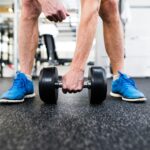Beyond the Scale: How Body Composition is the Secret to Lowering Breast Cancer Risk
We’ve all been conditioned to track our weight, but when it comes to long-term health and disease prevention, the number on the scale—or even your BMI—only tells a fraction of the story.
The latest and most compelling research shows that body composition—the amount of body fat versus muscle you have—offers a far more accurate picture of your overall health and, critically, your risk for breast cancer.
If you’re ready to take a truly proactive approach to prevention, here’s what you need to know about the fat-muscle connection and breast cancer risk, and how to optimize your body composition.
The Problem with Excess Body Fat
Excess body fat is an established risk factor for breast cancer, particularly for postmenopausal women. The danger doesn’t just come from overall fat, but where it’s stored. Studies have found that central obesity—excess fat measured by waist circumference or waist-to-hip ratio—is associated with a higher risk of breast cancer in both pre- and postmenopausal women [1].
In fact, one meta-analysis estimated that every 5% increase in body fat was linked to about a 15% higher risk of postmenopausal breast cancer [2].
Here are the three primary biological reasons why excess fat raises your risk:
1. Chronic Inflammation
Fat tissue, especially visceral fat (the kind stored deep in your abdomen), acts as a dysfunctional organ. It secretes pro-inflammatory chemicals called cytokines. This constant, low-level inflammation can damage healthy cells and create a microenvironment that promotes the growth and survival of cancer cells [3].
2. Hormonal Imbalance (Estrogen Production)
After menopause, your fat tissue becomes the primary source of estrogen production. More fat means more circulating estrogen, and high estrogen levels are directly linked to an increased risk of hormone-receptor-positive breast cancers [4].
3. Insulin Resistance
Being overweight or obese can lead to insulin resistance. In response, your body pumps out more insulin (hyperinsulinemia). High insulin levels are known to be a growth factor that can stimulate breast cancer cells and inhibit their natural death, thereby promoting tumor development [5].
The Protective Power of Muscle Mass
While excess fat is the villain, muscle mass is a powerful protector. The focus shouldn’t just be on losing fat, but on building and maintaining lean mass.
Research shows that women with non-metastatic breast cancer who have low muscle mass (a condition known as sarcopenia) have significantly lower survival rates compared to those with normal muscle mass [6].
Muscle works on your behalf by:
- Fighting Inflammation: Muscle tissue can help counteract the chronic inflammation caused by excess body fat.
- Improving Metabolism: A higher proportion of muscle helps improve insulin sensitivity and regulate the hormones associated with cancer risk.
Actionable Strategies to Optimize Your Body Composition
Since body composition is a modifiable risk factor, you have the power to reduce your risk through targeted lifestyle changes:
- Measure your body fat once a month, using an accurate BEI machine. This is why we have the InBody 570 at the Kirkland X Gym, and provide unlimited free tests for all members (including online members and app subscribers when they are in town).
- Sustain Weight Loss: Large-scale analysis of over 180,000 women demonstrated that sustained weight loss in women over 50 was significantly associated with a lower subsequent risk of breast cancer, with greater losses linked to larger reductions [7]. Even modest, sustained weight loss makes a difference.
- Strength Train Regularly: This is essential for building and preserving that protective muscle mass. Aim for two full-body strength-training workouts a week (just like we do at X Gym).
- Eat an Anti-Inflammatory Diet: Fuel your body with nutrient-rich foods like low glycemic fruits, vegetables, and healthy fats (e.g., olive oil, nuts, fatty fish). This helps to reduce chronic inflammation and support hormonal balance.
By monitoring your body composition, you gain the precise data needed to make lifestyle adjustments that support long-term health and cancer prevention.
Research References
- Central Obesity and Breast Cancer Risk: The relationship between central obesity and risk of breast cancer: a dose-response meta-analysis of 7,989,315 women. Frontiers in Nutrition. (https://www.researchgate.net/publication/375598710_The_relationship_between_central_obesity_and_risk_of_breast_cancer_a_dose-response_meta-analysis_of_7989315_women)
- Body Fat Percentage and Risk: Adult adiposity and risk of postmenopausal breast cancer: a pooled analysis of prospective studies. British Journal of Cancer. (https://www.canceraustralia.gov.au/breast-cancer-risk-factors/modifiable-factors/lifestyle-factors)
- Inflammation and Visceral Fat: Obesity and cancer: the role of adipose tissue and adipo-cytokines-induced chronic inflammation. International Journal of Molecular Sciences. (https://www.jcancer.org/v07p2346.htm)
- Hormonal Imbalance (Estrogen): Estrogens and breast cancer: mechanisms involved in obesity-related development, growth and progression. Scientific Reports. (https://pmc.ncbi.nlm.nih.gov/articles/PMC6502693/)
- Insulin Resistance: High insulin levels linked to deaths from breast cancer. The original finding was presented at the American Society of Clinical Oncology and reported in the Journal of Clinical Oncology. (https://pmc.ncbi.nlm.nih.gov/articles/PMC1118103/)
- Low Muscle Mass (Sarcopenia): Women With Low Muscle Mass Have Worse Survival. The finding relates to a study published in JAMA Oncology. (https://www.google.com/search?q=https://www.breastcancer.org/research-news/women-w-low-muscle-mass-worse-survival)
- Sustained Weight Loss: Sustained Weight Loss and Risk of Breast Cancer in Women Years: A Pooled Analysis of Prospective Data. Journal of the National Cancer Institute. (https://www.researchgate.net/publication/339537368_Re_Sustained_Weight_Loss_and_Risk_of_Breast_Cancer_in_Women_50_Years_A_Pooled_Analysis_of_Prospective_Data)









